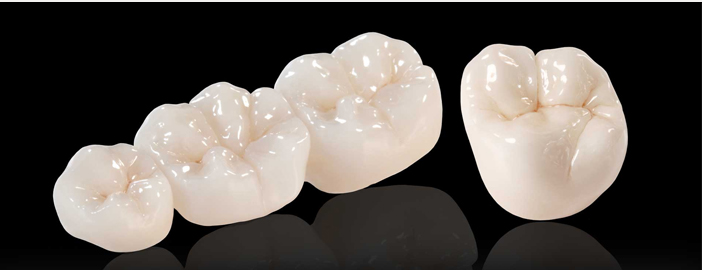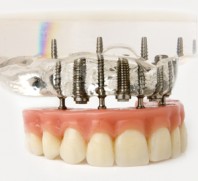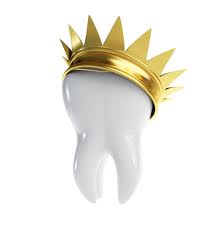Dental Crown Procedure

“The Dental Crown procedure is the lipstick of the dentistry world, take something ordinary add a cap and viola, instant beautiful smile”.
It takes more than one visit to fit and install the crown, and the additional time needed for the fulldental crown procedure can be long. Eventually, the increased benefits of a restored tooth using dental crowns will generally balance the equation.
The First Trip To The Dentist For Having a Dental Crown Procedure
Step One: Inspecting the tooth
Your dentist will first listen to your comments and complaints about your issue, which is very important. Your comments will help your dentist to determine where to look, and what could be the source of your pain. The dentist will inspect the teeth in the area where the pain is, as well as the surrounding area. Once your dentist is satisfied that a crown is needed, he will then proceed to numb the area and shaping the tooth.
Step Two: Numbing the tooth
Before your dentist starts the process, they will usually numb the tooth and the gum that surrounds the affected tooth using a local anesthetic, so that you don’t feel any more pain when he/she is poking around.
Step Three: Shaping the tooth
For the tooth to have an enough strength so you can chew properly, the crown must fit on your tooth and be in line with the other teeth. This usually means that the affected tooth must be reduced in size. If you are getting a porcelain dental crown, there is a minimum amount of thickness that it needs to be. If the porcelain crown is overly thin, it will break. So, the affected tooth must be shaved down, and when the crown is permanently cemented into place on the tooth will not be too big. Generally, the minimal thickness needed for a crown is approximately two millimeters, or one sixteenth of an inch.
If the tooth has been chipped or a chunk has broken off, your dentist may not need to do much reducing, but they will make sure that any decay has been removed. If your tooth has been chipped badly, or a large percentage of the tooth is unhealthy, it will not support the crown properly. In this case, your dentist will need to rebuild the tooth in order for the crown to fit appropriately A filling material is used to make the tooth bigger, and then it can be shaped to fit the crown.
For the dental crown to fit properly, the affected tooth must be shaped in a specific way, tapered, a bit thinner on the top and wider at the bottom. This makes sure that the dental crown will slip on easily, and will have the support it needs for chewing. The more tooth that there is inside the dental crown, the more stable the crown will be once it is attached.
Step Four: Making an impression of the tooth
Once the tooth has the proper shape to fit the dental crown, your dentist will make a replica of the tooth by making an impression. The crown will be based on this impression. There are two options of how the impression is taken:
1. The dentist can use a material called “impression material” to make the impression of the tooth. Impression material is basically like putty. The impression is sent over to the dental lab that will use that
impression to make a plaster cast. The lab will then create the crown so it fits perfectly on the plaster cast. The dental laboratory can take two or three weeks to create the crown.
2. If the dentist has a dental ceramic milling machine handy, they can make an impression of the tooth optically. Using this image, the machine will be able to create the crown and then manufacture it by shaping a block of porcelain, which will only take a few minutes. This method is much faster since the dentist can take the impression, create the crown and cement it in place in just a single appointment.
Milling machines are used to construct all ceramic/porcelain crowns, but your dentist may feel that a porcelain crown is not appropriate for your specific situation.
Step Five: Making the temporary dental crown
If your dental crown will be manufactured by on off site milling lab, you’will have to wait two or three weeks while the crown is being made, which means the dentist will make a temporary dental crown to cover the tooth. This protective crown can be made from plastic or a thin piece of metal, and will be cemented over the tooth.
Step Six: Choosing the right color for the porcelain crown
If the crown will be made of porcelain, or have a porcelain surface the dentist will need to choose the shade of porcelain that most closely matches the other teeth. It’s just like picking out paint. The dentist will have a few different pieces of porcelain with varied shades. They will hold up each piece until they find the shade that best matches your other teeth.
The Second Trip To The Dentist For a Dental Crown Procedure
Step Seven: Checking the fit.
When your new dental crown has arrived at the dentist’s office, it’s time to check how it fits. First, the tooth and surrounding tissue will be numbed using a local anesthetic, and if a temporary crown has been placed, it will be removed.
Next, your dentist will check and recheck the fit of the crown. Your dentist will place the new dental crown on to the tooth, and check that the fit is snug. They will usually inspect the fit using some dental floss, feeling it using a gapping tool, and they should ask you to gently bite down to make sure you are also comfortable with the fit. If the crown needs some adjustment the dentist will remove it, make the adjustment and recheck until it fits properly. If the crown is to be placed on a tooth that is in plain view, the dentist will need to ensure the color, shape and fit match the other teeth, and, most importantly, make sure that YOU are happy with how it fits and how it looks.
Step Eight: Cementing the dental crown in place
Once both, you and the dentist are happy with the fit, the color and shape, and that the dental crown is positioned correctly. The new tooth will be permanently cemented into place. First the dentist will put some dental cement on the inside of the crown, as well as on the tooth where the crown will go. The dentist then places the dental crown on the tooth, and will wait for a few moments for it to set. Once set, the dentist will use a tool to scrape away the excess cement that has been squeezed out from under the crown. The crown is now permanently in place, and the procedure is complete.
a Dental crown procedure will totally restore a smile that has any visual imperfections, really one of the best values in modern dentistry.
by SSI VA
Categories
Recent Posts
-

Dental Implants
Dec, 30, 2015
-
General Dental Crowns
Dec, 30, 2015
-
Terms & Conditions
May, 26, 2015
-
Payment & Privacy Terms
May, 26, 2015
-
Dental Surgery
May, 26, 2015
-
Orthopedic & General Surgery:
May, 26, 2015
-
Eye Surgery
May, 26, 2015
-
Plastic Surgery:
May, 26, 2015
-
Site Map
May, 26, 2015
-
Links
May, 26, 2015













Leave a Comment